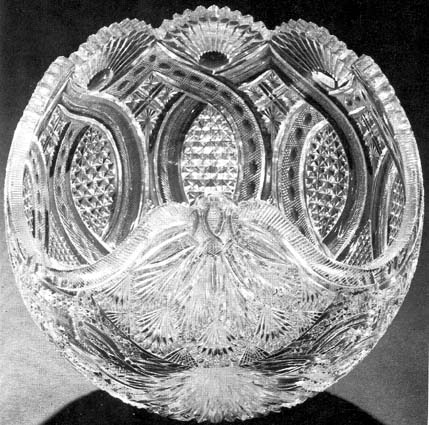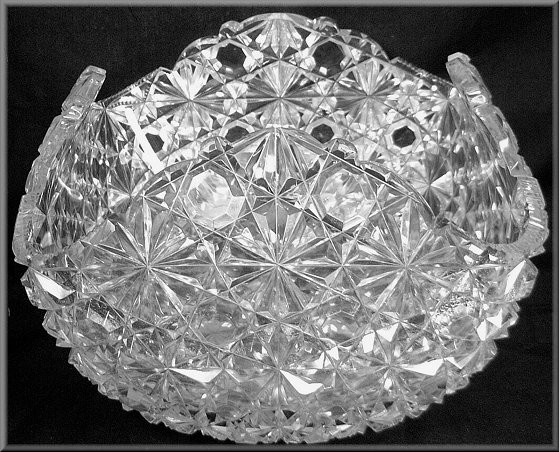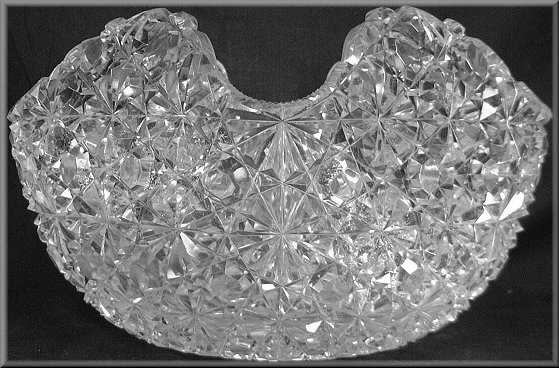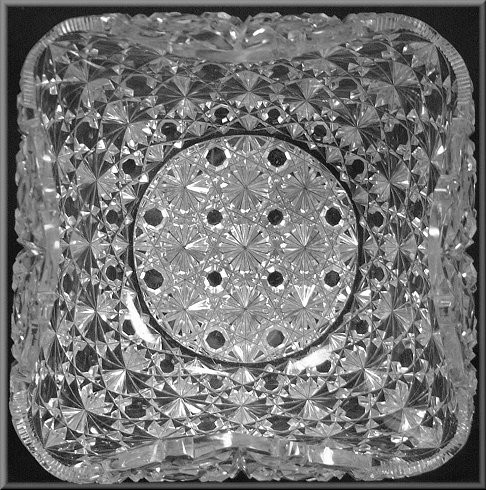
The two bowls discussed in this file were chosen (i) because their shapes are symmetrical in spite of being irregular. (Their irregularity is not unusual for the period represented, the 1880s.) and (ii) because the shape of the Stevens and Williams (England) bowl probably influenced the shape of the bowl made by the Mt. Washington Glass Company. (This bowl received special attention from the company: The shape was given a name, Tiffany, rather than a number, and the shape was patented.)
At first glance the Stevens and Williams bowl appears asymmetrical, as shown in the following image from Hajdamach (1991, p. 366):

A second glance, however, using a different view of the bowl, one provided by Williams-Thomas (1983, p. 71) clearly shows the bowl's symmetry:

Although Hajdamach, who provides additional views of the bowl, indicates that this particular item was made in 1886, the bowl, with a different pattern, could have been made earlier. Unfortunately, the extensive Stevens and Williams catalog has not yet been made available on the Internet. The writer assumes that the style of this bowl influenced that of the Mt. Washington bowl, which also dates from the mid-1880s, rather than the other way around. Unfortunately, evidence from these manufacturers that would permit a definitive statement is not yet available.
The following images of the Mt. Washington bowl also illustrate the difficulty in capturing a representative image of an irregularly shaped bowl, even one that is symmetrical. At least three different views are necessary: an oblique view, a profile view, and a plan view (interior), but one still longs for a three-dimensional representation:
Tiffany bowl (shape patented) by the Mt. Washington Glass Company, cut in the company's No. 60 pattern. Offered by the seller as "the Ambassador variation of the Russian pattern by Dorflinger" with "some minor chipping in the fields". L = 8.5" (21.6 cm) on a side, H = 6.35" (15.9 cm). The starting bid was $395 at an eBay auction in 2004, but, because there were no other bids, the bowl did not sell (Images: Internet).



This Tiffany bowl is illustrated in the MT. WASHINGTON GLASS CO. catalog (Padgett reprint) of c1885 as item no. 20 on plate 3. Note that at some time, probably when this page was reprinted, the black background in the bowl's photograph bled onto the image, radically changing the perceived shape of the bowl. In fact, it looks somewhat like an ice bowl with tabs. If the reader were to reconstruct the obliterated rim mentally he would see that the Tiffany bowl in the catalog matches the above bowl exactly. The bowl's deep scallops, serrated, is the main feature that suggests a Stevens & Williams influence. Incidentally, although the letters patent for the Tiffany bowl have not yet been located, a shape-patent for one of the other bowls in the catalog, the Martin bowl, is dated 1885. Therefore, the Mt. Washington catalog can not be dated earlier than this year. When the other patents are found, including the Tiffany patent, it may be necessary to give the catalog a later date.
Interestingly, retail prices are available for the Tiffany bowl, size not specified but probably about 9"D, cut in the following patterns: Strawberry Diamond, Hexagon Diamond (i.e., Hobnail), and No. 60 (i.e., Star and Hobnail or Russian Cleveland). Furthermore, each pattern was available in an "all over" cutting as well as one with a star-cut base. The latter versions are a bit less than 10% cheaper than the former. The illustrated bowl, with its No. 60 pattern cut "all over", was the most expensive of the offerings; it retailed for $42.00. Hexagon Diamond was 14% cheaper, and Strawberry Diamond fully 25% cheaper than No. 60. The least expensive of all the Tiffany bowls was the Strawberry Diamond bowl with star-cut base, $28.50.
Updated 22 Apr 2004